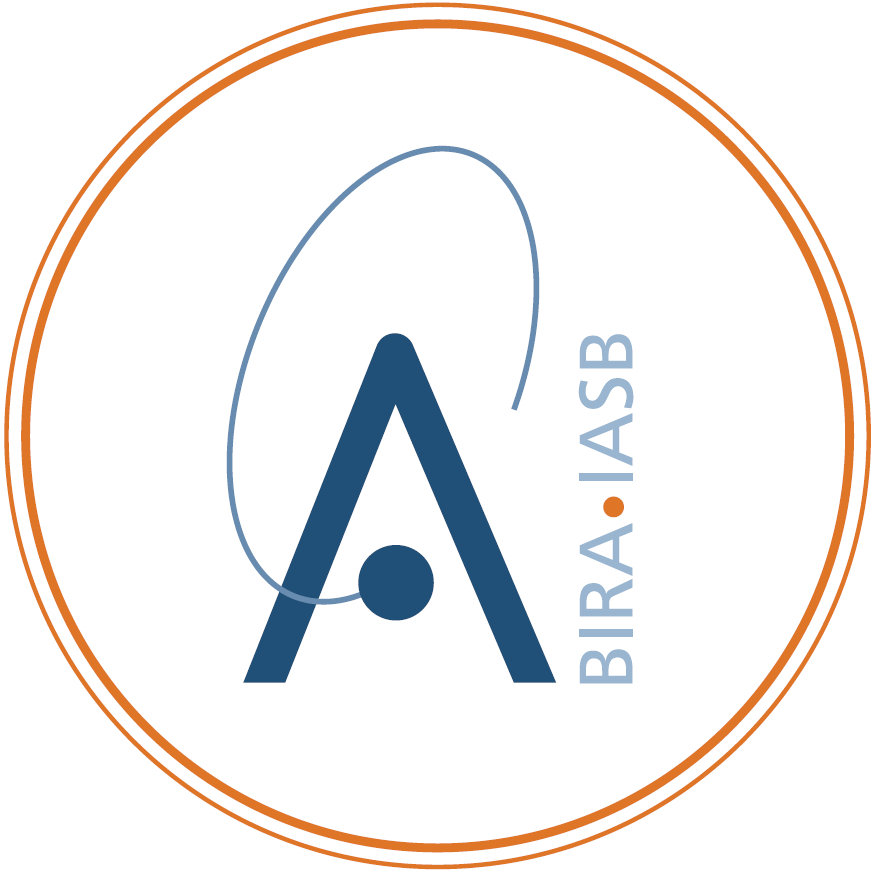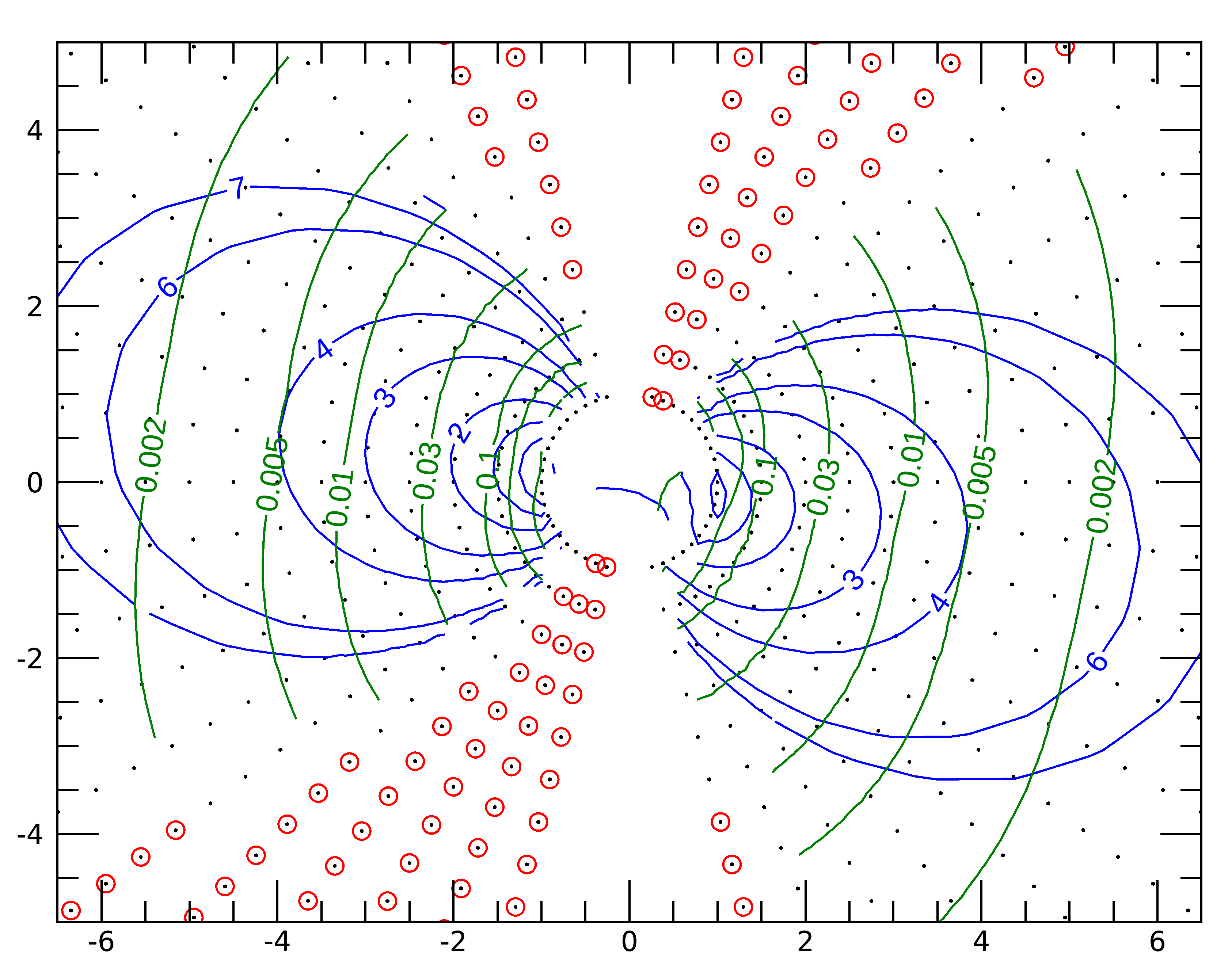
European Space Agency¶

Royal Belgian Institute for Aeronomy¶

Ex. #7. iso-contour of the shell parameter¶
Description¶
Note that this example has been performed using IDL, where the library can be directly linked to IDL (see FAQ G.06, and FAQ T.05), and that the IDL routine unilib is used to correctly initialized the library.
In this example, the subroutine
ul220()is called several times to evaluate the magnetic field intensity \(B_m\) and the McIlwain shell parameter L at different geographic positions in the plane that includes the Earth rotation axis and the geomagnetic dipole axis.The IDL routine
CONTOURis then used to display the results. The geomagnetic field model IGRF, epoch 1995, is used without external magnetic field for this computation. It is selected by a call to the subroutinesum510()andum520(). The longitude of the geomagnetic dipole axis is obtained by a call to subroutineut986().Be aware that the iso-contours of the shell parameter do not necessarily correspond to magnetic field lines.
Source¶
;
; Initialisation of the library
;
unilib
;
; Selection of the magnetic field model
;
ifail = 0L
label = '12345678901234567890123456789012'
status = CALL_EXTERNAL( 'unilib', 'UM510', 0L, 1995.0d0, label, 6L, ifail )
IF ifail LT 0 THEN STOP
status = CALL_EXTERNAL( 'unilib', 'UM520', 0L, 0.0d0, DBLARR(10), $
label, 6L, ifail )
IF ifail LT 0 THEN STOP
;
; Get the geomagnetic dipole axis
;
msun = {zxyz}
gm = 0.0d0
clatdip = 0.0d0
elngdip = 0.0d0
re = 0.0d0
status = CALL_EXTERNAL( 'unilib', 'UT986', gm, clatdip, elngdip, msun, re )
;
; Define a grid of points
;
colat = [INDGEN(21)*150./20.+15.,165.-INDGEN(21)*150./20.,15.] # (FLTARR(21)+1)
elong = [FLTARR(21,21),FLTARR(21,21)+180.,FLTARR(1,21)] + elngdip
radius = (FLTARR(43)+1) # (INDGEN(21)/2.+1)
z = radius * COS( colat*!dtor )
x = radius * SIN( colat*!dtor ) * COS( (elong-elngdip)*!dtor )
vallm = FLTARR (43,21)
valbm = FLTARR (43,21)
;
; Intermediate variables
;
fbm = 0.d0
flm = 0.d0
fkm = 0.d0
fsm = 0.d0
fbeq = 0.d0
fs = 0.d0
mpos = {zgeo}
;
; Loop on all the points
;
FOR i = 0, N_ELEMENTS( radius ) - 1 DO BEGIN
mpos.radius = radius(i)*re
mpos.colat = colat(i)
mpos.elong = elong(i)
ifail = 0L
status = CALL_EXTERNAL( 'unilib', 'UL220', mpos, 90.0d0, 1L, $
fbm, flm, fkm, fsm, fbeq, fs, ifail)
vallm(i) = flm
valbm(i) = fbm
ENDFOR
;
; Plot of the results
;
range = 5 * [-1,1]
rapp = 1.3
PLOT, [0], /nodata, xsty=3, ysty=3, xra=range*rapp, yra=range, chars=1.5
;
levlm = [ 1.2, 1.5, 2., 3., 4., 6., 8. ]
levbm = [ 0.002, 0.005, 0.01, 0.03, 0.1, 0.2, 0.4 ]
;
i = WHERE( vallm LT 0 )
IF i(0) GE 0 THEN BEGIN
OPLOT, x(i), z(i), psym=3, color=!p.color*0.2+!p.background*0.8
valbm(i) = -1
ENDIF
;
CONTOUR, vallm, x, z, min_val=0., /overplot, levels=levlm, $
c_labels=levlm*0, c_colors=!p.color*0.8+!p.background*0.2
CONTOUR, valbm, x, z, min_val=0., /overplot, levels=levbm, $
c_labels=levbm*0, c_colors=!p.color*0.5+!p.background*0.5
;
END
Results¶

The green and blue curves correspond to the L and \(B_m\) iso-contours, respectively. The red dots indicate geographic location where the subroutine ul220() failed to compute the value of L.¶
UNILIB/tags/v3.02
